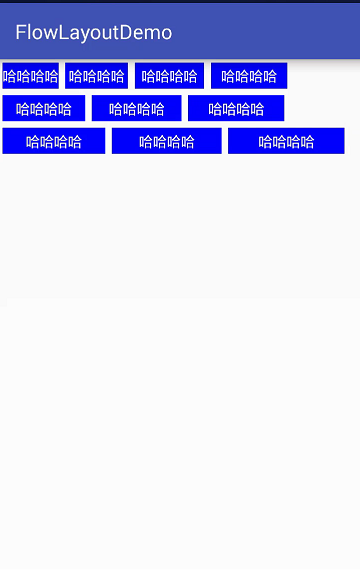本篇文章主要介绍了Android 简单实现一个流式布局的示例,分享给大家,具体如下: 流式布局应该是我们很常见的一种布局了,在很多场景下都会遇到它,例如:标签之类的功能等。用
本篇文章主要介绍了Android 简单实现一个流式布局的示例,分享给大家,具体如下:

流式布局应该是我们很常见的一种布局了,在很多场景下都会遇到它,例如:标签之类的功能等。用轮子不如造轮子来的爽,这里自己简单的实现下流式布局:
- onMeasure
- onLayout
通过以上两个方法我们就可以完成对流式布局的基本操作:
onMeasure
@Override
protected void onMeasure(int widthMeasureSpec, int heightMeasureSpec) {
super.onMeasure(widthMeasureSpec, heightMeasureSpec);
// 获得它的父容器为它设置的测量模式和大小
int sizeWidth = MeasureSpec.getSize(widthMeasureSpec);
int sizeHeight = MeasureSpec.getSize(heightMeasureSpec);
int modeWidth = MeasureSpec.getMode(widthMeasureSpec);
int modeHeight = MeasureSpec.getMode(heightMeasureSpec);
// 如果是warp_content情况下,记录宽和高
int width = 0;
int height = 0;
//记录每一行的宽度,width不断取最大宽度
int lineWidth = 0;
//记录每一行的宽度,不断累加每行最大高度获取height
int lineHeight = 0;
//获取子View的数量
int childCount = getChildCount();
//遍历每个子元素
for (int i = 0; i < childCount; i++) {
//获取每一个子View
View childView = getChildAt(i);
//测量每一个子View的宽和高
measureChild(childView,widthMeasureSpec,heightMeasureSpec);
//得到子View的lp
LayoutParam lp = (LayoutParam) childView.getLayoutParams();
//当前子View实际占据的宽度
int childWidth = childView.getMeasuredWidth() + lp.leftMargin + lp.rightMargin;
//当前子View实际占据的高度
int childHeight = childView.getMeasuredHeight() + lp.bottomMargin + lp.topMargin;
//如果加入当前childView,超出最大宽度,则得到目前最大宽度给width,类加height 然后开启新行
if (lineWidth + childWidth > sizeWidth) {
// 取最大的宽度
width = Math.max(lineWidth, childWidth);
//重新开启新行,重新计算
lineWidth = childWidth;
//叠加当前高度
height += childHeight;
//记录下一行高度
lineHeight = childHeight;
}else {
// 累加值lineWidth,lineHeight取最大高度
lineWidth += childWidth;
lineHeight = Math.max(lineHeight,childHeight);
}
// 如果是最后一个,则将当前记录的最大宽度和当前lineWidth做比较
if (i == childCount - 1) {
width = Math.max(width,lineWidth);
height += lineHeight;
}
}
setMeasuredDimension(modeWidth == MeasureSpec.EXACTLY?sizeWidth:width,modeHeight == MeasureSpec.EXACTLY?sizeHeight:height);
}
在onMeasure方法中负责设置子控件的测量模式和大小 根据所有子控件设置自己的宽和高,一旦宽度超出最大宽度便进行换行处理。高度不断累加从而获取最终高度。
onLayout
//存储所有的View,按行记录
private List<List<View>> mAllViews = new ArrayList<>();
//记录每一行的最大高度
private List<Integer> mLineHeight = new ArrayList<>();
@Override
protected void onLayout(boolean changed, int l, int t, int r, int b) {
mAllViews.clear();
mLineHeight.clear();
int lineWidth = 0;
int lineHeight = 0;
int width = getWidth();
int childCount = getChildCount();
// 存储每一行所有的childView
List<View> lineViews = new ArrayList<>();
for (int i = 0; i < childCount; i++) {
View childView = getChildAt(i);
LayoutParam lp = (LayoutParam) childView.getLayoutParams();
int childWidth = childView.getMeasuredWidth() + lp.rightMargin + lp.leftMargin;
int childHeight = childView.getMeasuredHeight() + lp.topMargin + lp.bottomMargin;
if (lineWidth + childWidth > width) {
// 记录这一行所有的View以及最大高度
mLineHeight.add(lineHeight);
// 将当前行的childView保存,然后开启新的ArrayList保存下一行的childView
mAllViews.add(lineViews);
lineWidth = 0;
lineViews = new ArrayList<>();
}
//如果不需要换行,则累加
lineWidth += childWidth;
lineHeight = Math.max(lineHeight,childHeight);
lineViews.add(childView);
}
// 记录最后一行
mAllViews.add(lineViews);
mLineHeight.add(lineHeight);
int left = 0;
int top = 0;
// 得到总行数
int size = mAllViews.size();
for (int i = 0; i < size; i++) {
// 每一行的所有的views
lineViews = mAllViews.get(i);
// 当前行的最大高度
lineHeight = mLineHeight.get(i);
for (View view : lineViews) {
LayoutParam lp = (LayoutParam) view.getLayoutParams();
//计算childView的left,top,right,bottom
int lc = left + lp.leftMargin;
int tc = top + lp.topMargin;
int rc = lc + view.getMeasuredWidth();
int bc = tc + view.getMeasuredHeight();
view.layout(lc,tc,rc,bc);
left += view.getMeasuredWidth() + lp.leftMargin + lp.rightMargin;
}
left = 0;
top += lineHeight;
}
}
通过onLayout方法给子View布局,前提,我们必须得知道每个子View的宽度和高度。所以我们先要在onMeasure的时候,测量一下每个子View的具体大小。
测试
public class MainActivity extends AppCompatActivity {
@Override
protected void onCreate(Bundle savedInstanceState) {
super.onCreate(savedInstanceState);
setContentView(R.layout.activity_main);
FlowLayout flowLayout = ((FlowLayout) findViewById(R.id.flowLayout));
FlowLayout.LayoutParam params = new FlowLayout.LayoutParam(ViewGroup.LayoutParams.WRAP_CONTENT, ViewGroup.LayoutParams.WRAP_CONTENT);
params.setMargins(10,10,10,10);
for (int i = 0; i < 10; i++) {
TextView textView = new TextView(this);
textView.setPadding(i * 10,10,i * 10,10);
textView.setBackgroundColor(Color.BLUE);
textView.setText("哈哈哈哈");
textView.setTextColor(Color.WHITE);
textView.setLayoutParams(params);
flowLayout.addView(textView);
}
}
}
这里我们要注意下FlowLayout.LayoutParam params = new FlowLayout.LayoutParam(ViewGroup.LayoutParams.WRAP_CONTENT, ViewGroup.LayoutParams.WRAP_CONTENT);这个方法,有的小伙伴在写的过程中可能点不出来这个方法,那是因为这个方法是需要我们自己写一个静态内部类来实现。
@Override
protected LayoutParams generateDefaultLayoutParams() {
return new LayoutParam(LayoutParams.WRAP_CONTENT,LayoutParams.WRAP_CONTENT);
}
@Override
public LayoutParams generateLayoutParams(AttributeSet attrs) {
return new LayoutParam(getContext(),attrs);
}
@Override
protected LayoutParams generateLayoutParams(LayoutParams p) {
return new LayoutParam(p);
}
public static class LayoutParam extends MarginLayoutParams{
public LayoutParam(Context c, AttributeSet attrs) {
super(c, attrs);
}
public LayoutParam(@Px int width, @Px int height) {
super(width, height);
}
public LayoutParam(MarginLayoutParams source) {
super(source);
}
public LayoutParam(LayoutParams source) {
super(source);
}
}
好了,这样一个简单的流式布局就结束了,有时候自己亲自敲一遍将它实现,才发现会学到很多。这里测试的代码是循环加入的View,大家也可以尝试的写个类似适配器的方式去实现。贴上源码供参考。
以上就是本文的全部内容,希望对大家的学习有所帮助,也希望大家多多支持自由互联。
